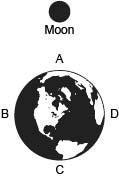
Chemistry, 15.12.2019 22:31 mommasgonzales01
Hon placed aquatic plants in several test tubes that were filled with water. then, he placed half of the test tubes in a dark closet and the other half in a well-lit room. when he recorded his data, some of the plants had formed many small bubbles on the leaves, and some did not.
which describes what hon most likely observed and the reason for these results?
a. the plants in the dark formed bubbles because they released hydrogen gas.
b. the plants in the dark formed bubbles because they released water vapor.
c. the plants in the light formed bubbles because they released carbon dioxide gas.
d. the plants in the light formed bubbles because they released oxygen gas.

Answers: 3


Another question on Chemistry

Chemistry, 21.06.2019 17:30
Aaspirin has a density of 1.40 g/cm^3 what is the volume in cubic centimeters of a tablet weighing 320 mg?
Answers: 3

Chemistry, 22.06.2019 01:30
100 points answer quick the table compares the number of electrons in two unknown neutral atoms. comparison of electrons atom number of electrons a 10 d 11 use this information to determine the number of valence electrons in the atoms. which of the following correctly compares the stability of the two atoms? both are unreactive. both are highly reactive. a is unreactive and d is reactive. a is reactive and d is unreactive.
Answers: 1

Chemistry, 22.06.2019 06:00
Oxidation-reduction reactions (often called "redox" for short) are reactions that involve the transfer of electrons from one species to another. oxidation states, or oxidation numbers, allow chemists to keep track of these electron transfers. in general, one element will lose electrons (oxidation), with the result that it will increase in oxidation number, and another element will gain electrons (reduction), thereby decreasing in oxidation number. the species that is oxidized is called the reducing agent or reductant. the species that is reduced is called the oxidizing agent or oxidant. to sum up: oxidation = increase in oxidation state = loss of electrons = reducing agent reduction = decrease in oxidation state = gain of electrons = oxidizing agent part a which element is oxidized in this reaction? fe2o3+3co→2fe+3co2 enter the elemental symbol. view available hint(s) is oxidized part b which element is reduced in this reaction? 2hcl+2kmno4+3h2c2o4→6co2+2mno2+2kcl+4h2o enter the elemental symbol. view available hint(s) is reduced
Answers: 1

Chemistry, 22.06.2019 07:00
The blackbody curve for a star name zeta is shown below. what is the peak wavelength for this star ?
Answers: 1
You know the right answer?
Hon placed aquatic plants in several test tubes that were filled with water. then, he placed half of...
Questions





Chemistry, 14.10.2020 01:01



Biology, 14.10.2020 01:01


English, 14.10.2020 01:01



Social Studies, 14.10.2020 01:01



Mathematics, 14.10.2020 01:01

History, 14.10.2020 01:01

Mathematics, 14.10.2020 01:01

English, 14.10.2020 01:01

Mathematics, 14.10.2020 01:01




